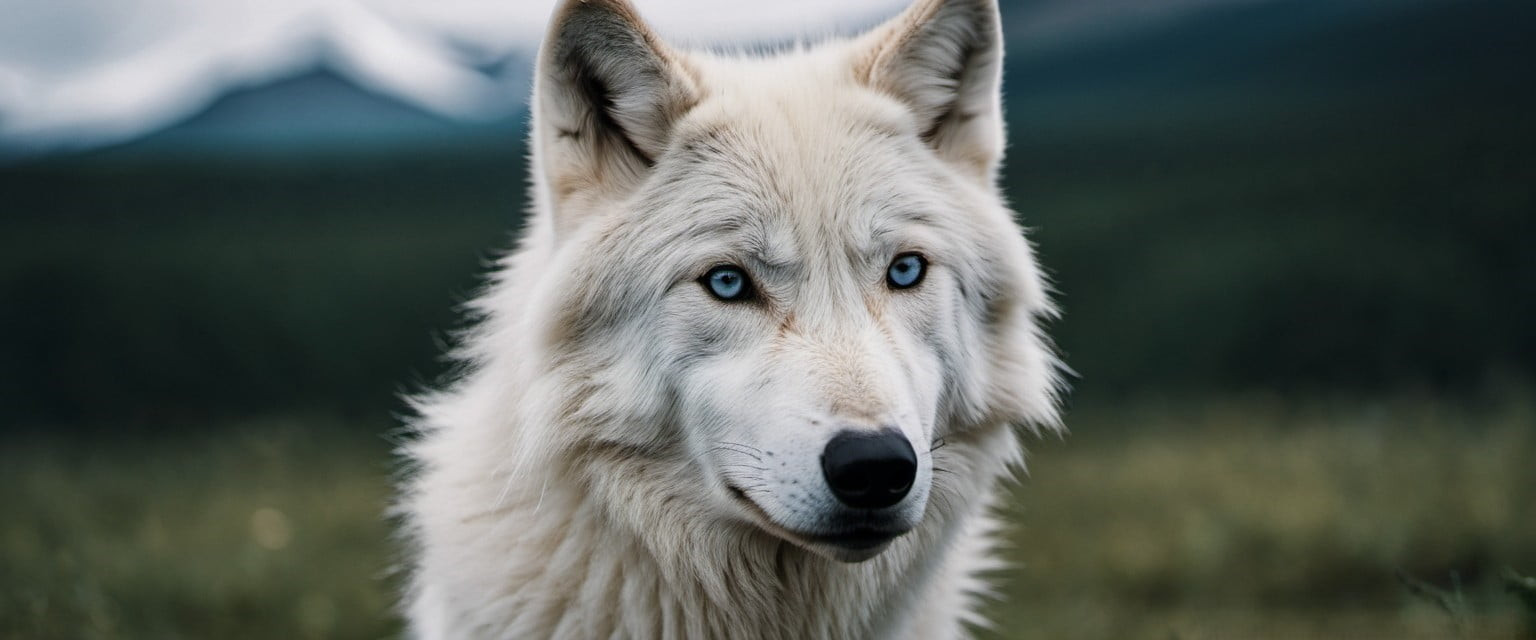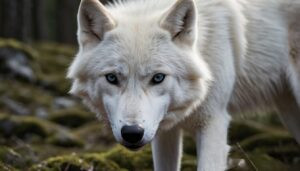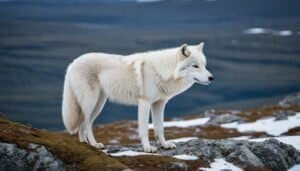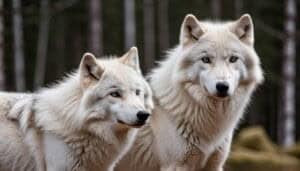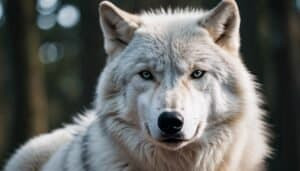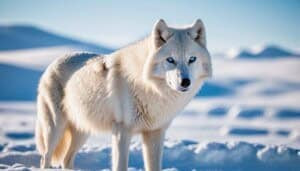Introduction
In this article, we will explore the remarkable hearing capabilities of the Arctic wolf. We will begin by discussing the maximum distance these wolves can hear and how their hearing compares to other wolves and humans
Next, we will delve into the factors that influence their hearing range, including environmental conditions and specific adaptations that enhance their auditory abilities. Additionally, we will examine how Arctic wolves utilize their hearing for hunting and communication
Finally, we will look at the frequencies they can detect and how their hearing develops from a young age. Join us as we uncover the fascinating auditory world of the Arctic wolf
Maximum Distance and Hearing Capabilities
Arctic wolves possess remarkable hearing abilities that play a crucial role in their survival in the harsh, icy wilderness. In this section, we will explore the extent of their hearing range and compare their auditory capabilities to other wolves and humans
What is the Maximum Distance an Arctic Wolf Can Hear?
Arctic wolves can hear sounds from a considerable distance, often up to several miles away, depending on various factors such as the terrain, weather conditions, and the volume of the sound
In the open tundra, where sound waves travel more freely due to the lack of obstructions, these wolves can detect noises from up to 6 miles away. This exceptional hearing range allows them to locate prey and stay aware of potential dangers in their vast, desolate habitat
How Does the Arctic Wolf’s Hearing Compare to Other Wolves?
When comparing the hearing abilities of Arctic wolves to other wolf species, it’s evident that they share similar auditory capabilities. However, the specific adaptations of Arctic wolves to their unique environment might give them a slight edge
For instance, the quieter, less populated tundra means that Arctic wolves rely more heavily on their hearing to detect distant sounds, whereas wolves in denser forests might depend more on other senses like sight and smell
Despite these environmental differences, all wolves have highly sensitive ears capable of picking up a wide range of frequencies and sounds that are imperceptible to humans
Can Arctic Wolves Hear Better Than Humans?
Arctic wolves, like other wolf species, have a significantly better hearing range than humans. While the average human hearing range is between 20 Hz to 20 kHz, wolves can hear frequencies as low as 16 Hz and as high as 40 kHz. This extended range allows them to detect high-pitched sounds and low-frequency vibrations that humans cannot perceive
Additionally, their ability to pinpoint the exact location of a sound source is far superior, thanks to their large, mobile ears that can independently rotate to capture sounds from different directions. This heightened auditory sense is vital for their communication, hunting, and survival in the Arctic wilderness
Factors Influencing Hearing
The impressive hearing range of Arctic wolves is influenced by various factors. In this section, we will examine what affects their auditory capabilities, how environmental conditions come into play, and the specific adaptations that enhance their hearing
What Factors Influence the Hearing Range of an Arctic Wolf?
Several factors impact the hearing range of an Arctic wolf, including:
Age: Younger wolves typically have better hearing than older wolves, as their auditory systems are less likely to be affected by age-related degradation
Health: Wolves in good health with no ear infections or other auditory impairments will have a better hearing range
Genetics: Genetic factors can influence the sensitivity and acuity of a wolf’s hearing, with some individuals possessing superior auditory abilities
Experience: Wolves that have honed their hunting and survival skills over years may be better at interpreting sounds and discerning important auditory information
How Do Environmental Conditions Affect an Arctic Wolf’s Hearing?
Environmental conditions play a significant role in the effectiveness of an Arctic wolf’s hearing. Key factors include:
Terrain: Open, flat terrains such as the tundra allow sounds to travel further than in forested or mountainous regions where obstacles can block or absorb sound waves
Weather: Weather conditions like wind, rain, and snow can influence how sound travels. For instance, snow can dampen sound, making it harder for wolves to hear, while still air can carry sounds much further
Temperature: Cold temperatures can affect the density of the air, altering the way sound waves propagate. In colder, denser air, sound can travel further than in warmer conditions
What Adaptations Do Arctic Wolves Have for Enhanced Hearing?
Arctic wolves have developed several adaptations to enhance their hearing abilities:
Large, Rotatable Ears: Their large ears can rotate to capture sound from multiple directions, allowing them to detect the source of a noise accurately
Frequency Range: Arctic wolves can hear a broader range of frequencies compared to humans, enabling them to pick up on sounds that are inaudible to us
Auditory Acuity: They have highly sensitive auditory systems that can discern subtle differences in sound intensity and frequency, crucial for identifying prey and communicating with pack members
Noise Filtering: Arctic wolves can filter out background noise to focus on specific sounds, such as the movements of prey or the calls of other wolves, even in the midst of environmental noise like wind or running water
These factors and adaptations work together to ensure that Arctic wolves can rely on their exceptional hearing to survive and thrive in the challenging Arctic environment
Hearing in Hunting and Communication
Arctic wolves utilize their acute hearing for critical activities like hunting and communication. In this section, we will explore how their hearing aids them in locating prey and how they use it to communicate with each other
How Does an Arctic Wolf’s Hearing Help It Hunt?
Arctic wolves rely heavily on their sense of hearing to hunt effectively. Their keen hearing allows them to detect the slightest sounds made by potential prey, even from a distance. Here are a few ways their hearing assists in hunting:
Detecting Movement: Arctic wolves can hear the rustle of prey moving through the snow or underbrush. This early detection gives them the advantage of preparing for a stealthy approach
Locating Prey: By pinpointing the exact location of sounds, wolves can accurately locate hidden or camouflaged prey. Their ability to discern the direction and distance of sounds helps them stalk and ambush animals like hares, birds, and even larger prey such as caribou
Coordinating Hunts: In pack hunting, communication through sound is vital. Wolves use a series of barks, howls, and other vocalizations to coordinate their movements and strategies during a hunt. Their hearing ensures they stay synchronized and can adjust their tactics as needed
How Do Arctic Wolves Use Their Hearing to Communicate?
Communication is essential for the social structure and survival of Arctic wolves. They use their hearing to interpret and respond to various vocalizations and sounds made by their pack members. Key aspects of communication include:
Howling: Howling is a primary method of long-distance communication among wolves. It serves multiple purposes, such as rallying the pack, marking territory, and signaling distress or danger. The distinct pitch and tone of a howl can convey different messages, and the ability to hear these howls over long distances is crucial
Barking and Whining: Short-range communication often involves barks, growls, and whines. These sounds can indicate different emotions or intentions, such as playfulness, aggression, or submission. Wolves rely on their hearing to understand these nuanced vocalizations and respond appropriately
Social Bonding: Pups and adult wolves use vocalizations to strengthen social bonds within the pack. Pups often make high-pitched sounds to communicate with their mothers and other pack members. The sensitive hearing of wolves allows them to detect and respond to these sounds, fostering close-knit relationships
The sophisticated use of hearing in hunting and communication highlights the importance of this sense in the daily lives and survival strategies of Arctic wolves. Their ability to hear and interpret a wide range of sounds ensures they can hunt efficiently and maintain strong social structures within their packs.
Hearing Development and Frequencies
In this final section, we will delve into the specific frequencies that Arctic wolves can detect and how their hearing develops from a young age
What Frequencies Can Arctic Wolves Hear?
Arctic wolves have an impressive hearing range that surpasses that of humans. They can detect sounds ranging from 16 Hz to 40 kHz. This broad frequency range allows them to hear both very low-frequency sounds, such as distant footsteps, and high-frequency sounds, such as the squeaks of small rodents
Here’s a breakdown of their frequency detection capabilities:
Low Frequencies: Sounds below 20 Hz, which humans cannot hear, are detectable by wolves. These low frequencies are often associated with distant or large movements, helping wolves sense potential threats or prey from afar
High Frequencies: Wolves can hear sounds up to 40 kHz, which includes the high-pitched calls of small prey animals. This ability to detect high frequencies is crucial for hunting small, quick-moving animals that might otherwise go unnoticed
How Do Arctic Wolf Pups Develop Their Hearing Abilities?
The development of hearing in Arctic wolf pups is a gradual process that starts shortly after birth. Here’s an overview of how their hearing abilities evolve:
Early Development: Wolf pups are born deaf, with their ear canals closed. Their hearing begins to develop within the first two weeks of life as their ear canals open up
Learning to Listen: As the pups grow, they start to respond to sounds around them. Initially, they react to loud noises and their mother’s vocalizations. This stage is crucial for their auditory development and social bonding
Refining Skills: By the time they are a few months old, pups have developed their full hearing range. They begin to practice using their hearing for hunting and communication, mimicking the adults and learning from their environment. This period is essential for honing their skills and adapting their hearing to the specific challenges of their Arctic habitat
Conclusion
Arctic wolves are equipped with extraordinary hearing capabilities that are essential for their survival in the harsh Arctic environment. Their ability to hear sounds from up to several miles away allows them to effectively detect and hunt prey, as well as stay alert to potential dangers
When compared to other wolves and humans, Arctic wolves have a superior hearing range, detecting frequencies between 16 Hz and 40 kHz. Various factors such as age, health, genetics, and environmental conditions influence their hearing range, and their large, rotatable ears and auditory acuity provide significant advantages
Their hearing plays a crucial role in hunting, enabling them to detect and locate prey accurately, as well as coordinate pack movements during hunts. Communication within the pack relies heavily on their auditory abilities, with howling, barking, and whining being integral to social bonding and coordination
From birth, Arctic wolf pups gradually develop their hearing, starting from being deaf to fully acquiring their impressive auditory range within a few months. This development is vital for their integration into the pack and learning essential survival skills
Overall, the remarkable hearing abilities of Arctic wolves illustrate their adaptation to the extreme conditions of their habitat, ensuring their continued success as hunters and social animals in the Arctic wilderness
